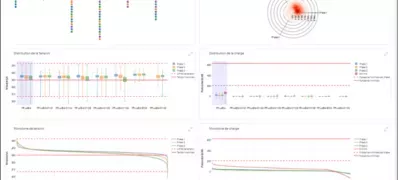
The 2023 UN climate summit, which wrapped on December 13, delivered progress across several critical global priorities and defied early prognostications that COP28 — hosted by Dubai, in the United Arab Emirates, one of the world’s largest fossil fuel exporters — would bog down in dissent.
On the conference’s first day came a surprise agreement to operationalize the Loss and Damage Fund, a long contentious issue between low-income, low-emissions countries, and wealthy heavy emitters. Soon thereafter came a spate of deals to rapidly lower the leakage of methane, a super-warming gas, from government, NGO, and corporate players.
And on the event’s final day came a historic, unanimous agreement on “transitioning [the world] away from fossil fuels in energy systems… in a just, orderly and equitable manner.” Complementing that milestone: a commitment to triple the world’s capacity of wind, solar, and other renewable energy by 2030, concurrent with a doubling of the pace of energy efficiency gains.
“COP28 has clarified to everyone that the direction of the transition is clear,” said RMI CEO Jon Creyts. “The energy transition is unstoppable.”
Even as the clean energy shift gathers pace, COP28’s final statement also offered a stark reminder of the urgency for faster action. The “global stocktake,” the UN’s inventory of the world’s progress on reducing greenhouse gas emissions, concluded that we are well off track to limit global warming to 1.5°C by 2100, as agreed to in Paris.
To limit warming to the Paris target, emissions would need to fall by 43 percent by 2030, and 60 percent by 2035, relative to 2019 levels. For now, emissions are on track to fall by just 5 percent come 2030, and only if every country’s commitment is met. Consequently, the world remains on a path to heat by up to 2.8°C by the turn of the century, almost twice the 1.5°C goal.
For RMI’s on-the-ground work, COP28’s complex climate diplomacy nets out as a cause for optimism. As never before, the agreement galvanized global governmental consensus in line with many of our long-standing goals, particularly around speeding the shift to cleaner, safer energy, reducing methane, and the just energy transition. At the same time, the agreement did not resolve pressing areas, such as financing, that will be essential to achieve its goals.
Below, RMI experts weigh in on the implications of the conference’s big advances, as well its less covered wins, along with a few misses.
Multiple methane wins
Over 80 times more potent near term than carbon dioxide (CO2) as a warming agent, methane offers huge potential to quickly cut global greenhouse gas emissions. And to keep 1.5. degrees within reach this decade, oil and gas methane leaks must go to near zero. What’s more, the technical solutions are here now, and the economics are highly favorable, with over half of the fixes yielding a profit or zero net cost. RMI Principal TJ Conway highlights COP28’s methane wins.
Oil and gas commitment. Heading into COP28, methane ranked as a top prospect to deliver major agreements on emissions reductions. Sure enough, over 50 global energy players signed onto the Oil and Gas Decarbonization Charter (OGDC), committing to reach “near zero” methane leakage and flaring by 2030 — an ambitious goal under a tight timeline. This multistakeholder effort was notable both for its scale (signatories account for over 40 percent of global oil production) and the buy-in of global oil giants such as BP, ExxonMobil, Shell, and major national oil companies (NOCs), many of which are otherwise insulated from pressures to set climate goals. NOCs represented a remarkable 60 percent of participants. The US Enviromental Protection Agency also released stricter regulations on methane emissions.
Building accountability. The bulk of the methane discussions at COP28 focused on the need to accelerate implementation — namely, how to establish accountability mechanisms and metrics to ensure that companies credibly and rapidly meet their OGDC commitments. In coordination with OGDC — and together with Bloomberg Philanthropies, EDF, the IEA, and UNEP via the International Methane Observatory — RMI unveiled a new initiative that will help advance transparency and enforce accountability around claims of methane emissions reductions.
Financing methane reductions delivered another front of progress. The World Bank’s announcement of a new $255 million trust fund through the revamped Global Flaring and Methane Reduction Partnership was welcomed, especially given that many NOCs need technical and financial support. As funding to reduce methane multiplies, financial institutions need more robust ways to track and validate carbon reductions in their lending portfolios; stronger standards will unlock more funding for reductions. For a fuller explanation of RMI’s work to establish supporting standards for lenders, see “Carbon on balance sheets may go up before they can go down” below.
Curtailing waste methane. Progress on methane extended past the petroleum patch. The waste sector, including solid waste and wastewater, is the third largest contributor to methane emissions, responsible for almost 20 percent of the global total. And as part of COP28, RMI and Clean Air Task Force, with funding support from The Global Methane Hub and Google.org, unveiled the Methane Assessment Platform (WasteMAP), a new, open, online tool that aggregates and maps reported, modeled, and observed waste methane emissions data to help guide reductions.
Scaling green industry
Perfecting clean technologies — from lower-carbon recipes for steel to sustainable aviation fuels — isn’t enough. Industry must also change how it does business, such as developing better ways to finance, buy, and cultivate long-term demand for low-carbon solutions. RMI’s Charlotte Emerson discusses the major initiatives RMI took part in at COP28 to spur these sorts of market-based advances in strategic industries.
Hydrogen. Given its potential to help other heavy-emitting sectors — such as steel and shipping — decarbonize, green hydrogen is a top priority. The Green Hydrogen Catapult launched the report The Value of Green Hydrogen Trade for Europe, at the event Trading Green Hydrogen to Bolster Energy Security, which focused on the value of renewable hydrogen exports in promoting global energy security. The Green Hydrogen Catapult signed a joint declaration in partnership with UN High-Level Climate Champions on the Responsible Deployment of Renewables-Based Hydrogen, addressing the need for mutual recognition of a broad range of recommendations guiding the deployment of renewables-based hydrogen around the world.
Steel. RMI co-hosted an event with the World Economic Forum’s First Movers Coalition and corporations across the industrial supply chain to speed the decarbonization of heavy industry. A centerpiece of this push, RMI’s Sustainable Steel Buyers Platform, demonstrates how connecting ambitious buyers and suppliers through demand-side measures can accelerate the shift to low-emissions steel. RMI also signed the Steel Standards Principles, an effort to harmonize the methodology and standards to define lower emissions steel.
Shipping. The UN High-Level Climate Champions and RMI’s Green Hydrogen Catapult facilitated the Green Hydrogen and Green Shipping Call to Action, committing 30 shipping sector actors to firm targets to use nearly 11 million tons of renewables-based hydrogen fuel adoption this decade — nearly 10 percent of all fuel consumption. A related event, Clearing the Last Mile: Opportunities for Supplying Zero-Emission Fuels at Ports, unveiled initial findings on the cost and ability of key ports to supply the zero-emission shipping fuels of the future by 2030 from a forthcoming study undertaken by RMI and Global Maritime Forum under the flag of the Zero-Emission Shipping Mission.
Aviation. RMI, together with the Environmental Defense Fund and the Sustainable Aviation Buyers Alliance (SABA) launched the SAFc Registry, a not-for-profit sustainable aviation fuel certificate registry that will transparently and rigorously connect corporate aviation customers to clean fuel deployment, reducing emissions from air travel and air freight.
Aluminum. Financial institutions play an essential behind-the-scenes role in funding investment in greener options. Consider aluminum, which is playing a rising role in the energy transition as a lightweight, highly recyclable material in everything from wind turbine components to solar panel framing. To encourage a shift toward production of low-emissions aluminum, RMI unveiled the Sustainable Aluminum Finance Framework a tool for banks to benchmark their aluminum clients and collaboratively develop decarbonization pathways with industry.
Prioritizing, and funding, a just energy transition
The push to gather funding to compensate poor, low-emitting countries for harm they are experiencing from climate change has been contentious and opposed for 30 years at past COPs by heavy emitters, including the United States. COP28 delivered laudable progress in funding commitments. Above all, improved and expedited access to climate funds will be critical for the most vulnerable countries. For future COPs, the issue persists as one of the most urgent — and delicate — fronts. RMI Senior Principal Laetitia De Marez explains.
Loss and damage. The push to gather funding to compensate poor, low-emitting countries for harm they are experiencing from climate change has been contentious, opposed at past COPs by heavy emitters, including the United States. COP28 delivered laudable progress in funding commitments. Above all, improved and expedited access to climate funds will be critical for the most vulnerable countries. Many were surprised then, to see COP28’s first day deliver an agreement on the loss and damage fund, with funding and an agreement to house it at the World Bank. Pledges quickly stacked up: Over $700 million has been committed initially, including $17.5 million from Washington, a pledge which, while nominal, marks the end of US opposition. The tally remains far short of the $100 billion target requested by developing countries, but the establishment of a vehicle is a critical step to bring in ongoing funding and distribute it.
Reforming multilateral development banks. It’s a big step forward. But the financial gap remains considerable compared to the capital needed to fund a fast, yet just, transition. The reform of the multilateral development banks (MDBs, such as the World Bank, Asian Development Bank, and others) must continue and deepen. They need to transition their portfolios, terms, conditions, and policies away from future fossil deals and fully switch to Paris-aligned investment priorities.
Public-private financial collaboration. The climate funds and the MDBs have a critical role to play in mobilizing international and national private sectors by de-risking and aggregating projects in the regions. The imperative is growing to blend public and private sources of capital — a shift that is underway but must be streamlined and scaled (more on this in the next section on global financiers).
Capacity building: Skills, workforce, regulations. International capacity-building support and technology transfer mechanisms to enable the energy transition remain underfunded and undersized. Transitioning energy systems cannot be achieved without a skilled workforce, trained energy leaders, regulators, innovators, and developers.
Defining a better transition. It remains unclear what a just and equitable transition means for different countries: What are the developmental, resilience, economic, and social progress elements of the just transition? Research and consultations are urgently needed to define and tailor strategies to each country’s circumstances and realities.
For global financiers, impact trumps pledges
Progress on loss and damage funding at COP28 is an important step forward. Yet it also reminds us that the wider scale of transitioning the entire global economy in line with climate goals will require massive capital investment — estimated at roughly $200 trillion to $275 trillion by 2050.
To hit that goal, the private sector must play a bigger role. And while green finance has already gained significant momentum, increasing 100-fold in the past decade, uncertainty still exists around the implementation of “transition finance” to decarbonize high-emitting and/or hard-to-abate sectors. Adapting today’s financial market practices to better accommodate the needs of transition finance can help unlock the flow of climate capital. RMI Managing Director Brian O’Hanlon sees these priorities:
Bridging the public-private financing gap. To deliver full-scale deployment of commercially proven clean energy technologies in Africa and throughout emerging markets, lenders and projects need to move beyond grant-funded demonstration projects, and de-risk portfolios of investments to better meet international financing requirements. These steps can help mobilize international private capital at scale, while ensuring that local project developers do the real work on the ground. With a project pipeline of $464 million in the Pacific, the Climate Finance Access Network (CFAN) offers a practical and actionable solution to developing countries facing capacity constraints in accessing climate finance.
Carbon on balance sheets may go up before they can go down. A key challenge of transition finance includes the risk of financial institutions divesting from high-emitting sectors on paper, but without delivering real reductions. This can happen when financial institutions sell their emitting assets, and can thus show decarbonization progress on their balance sheets. Yet the underlying assets and their related emissions haven’t changed however, only their owner has.
There are ways to overcome these barriers. At COP28, RMI created consensus on how to do so. For investors who have pledged to decarbonize their portfolios, more reliable ways to classify and track underlying emissions reductions is growing as initiatives such as the methane rules and agreements (see above) get traction. Investors need rules of engagement to clarify when financing methane abatement in fossil fuel progress results in overall emissions reductions or simply prolongs the life of emitting assets in ways that are incompatible with preventing disastrous temperature rise.
Climate impact from financial decisions. Shifting from past measures to future forecasts. Historically, investors and lenders have primarily looked at past emissions to assess progress toward climate goals — this method is essentially a look in the rear-view mirror. Now, regulators and climate experts are increasingly demanding forward-looking metrics that offer a more accurate assessment of future results by better modeling how financial decisions made today will affect the future trajectories of decarbonization and resilience of local economies. To support this shift, RMI leads the development of PACTA, a software application that predicts the climate impact of entire financial portfolios of investment and activities, often spanning multiple sectors and geographies.
Challenges ahead
As the world digests the implications of COP28’s agreements — and omissions — priorities for COP29, in Baku, Azerbaijan, are already becoming clear. Three are on our radar:
Renewables and the grid. The world has given itself just seven years to hit the ambitious goals of tripling renewable energy (3xRE) and doubling efficiency gains. This will require a steep ramp up in deployment in both developed and developing markets — including streamlined financing, quicker regulatory approvals, streamlining supply chains, and more rapid grid growth. Over the past decade, the average wait time to connect clean energy projects to the US grid has doubled to four years; in Europe and the United States delays to approve, build, and connect new clean energy projects can exceed 10 years. Unlocking ways to upgrade and improve access to the grid are emerging as some of the toughest barriers to increasing renewables’ market share.
Carbon markets. In Dubai, negotiations around carbon markets (Article 6) collapsed and will need to be rebooted next year. Carbon markets remain a potentially powerful market solution to reduce emissions, yet voluntary markets faced multiple setbacks in 2023. RMI is working on multiple fronts to help mature these markets.
Finance. The New Collective Quantified Goal will take over from the rich world’s long-unfilled commitment to relay $100 billion per year to developing regions. This funding is growing in importance as renewables growth shifts into the Global South. Much of the world’s renewables growth (above) will be centered in the developing world, where most of the world’s economic growth, urbanization, and construction will unfold in coming decades. Many need help both building new clean energy systems, as well as aid in unwinding legacy fossil-fuel-based energy infrastructure. Projects in poorer countries remain more expensive and harder to finance and build, compared to richer regions, given higher risk premiums. Closing this gulf will help unleash faster renewables growth.
By Adam Aston, RMI
More on RMI



